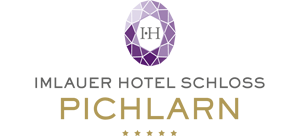ART
in the castle
The IMLAUER Hotel Schloss Pichlarn is showing abstract paintings by the following artists in the winter garden:
Gottfried Mairwöger
*1951 in Tragwein
† 2003 in Vienna
Réunion (1998)
Oil on linen, 150 x 135 cm
The works “Amber” and “Réunion” were created in 1998 and tell of iridescent nuances of light on an ultramarine blue sea. The pictures were taken after his stay on the island Mauritius, located east of Africa in the Indian Ocean. Mairwöger traveled to the island twice for for a period of 6 months to discover new elements for his painting.
“Amber” and “Réunion” were among the first in this new style, which Mairwöger continued to pursue until his death in 2003. Wide, flat areas are complemented by narrower, linear-looking color gradients and occasionally integrated into the composition in the sense of precisely controlled color overlaps. Here and there, the painter makes use of the dilution and transparency of certain colors, allowing them to gently intertwine and employing a coloration that is very typical for him, which can be attested to a successful symbiosis of closeness to nature, an understanding of nature and a deliberate artificial approach to which the artist continually commits himself.
Levente Szücs
*1989 in Miskolc (Hungary)
Oil on linen, 150 x 135 cm
“Augmented reality” is the name given to a digital extension of a real state. Levente Szücs uses this principle in his art. It’s not graphic lines, texts, sounds or other obvious things, and he doesn’t need a computer to do it. It is painting versus photographic image. The spots of color are, incidentally, also part of reality – not of the forest, but possibly of an individual way of seeing or perceiving. But they are certainly indivisible and unmistakably synonymous with painting.
When “augmented reality” gives places or objects an extended reality, this is basically what it has learned from art. Multidimensional experiences and interpretations of reality were almost always triggered there. Today, advanced digital technologies not only enable artists to manipulate reality. Corresponding apps on the smartphone are also sufficient for the layman.
The forest is one of the most significant themes in the history of painting and culture. At the same time, it is a place of romance, relaxation, the sinister, the threatening and home to all kinds of creatures and beings of darkness. Informal painting, on the other hand, has a heroic approach that turns the painter into a medium, into a perpetrator. He fights his way through the thicket (of painting) to tell the audience about the reality he has experienced.
Stefan Glettler
*1980 in Graz
Oil on canvas150 x 135 cm
Stefan Glettler was born in 1980 in Graz, Austria. He lives and works in Vienna and Styria.
2000 – 2005 Studied painting and graphics at the Academy of Fine Arts, Vienna.
In Stefan Glettler’s work, there is no rigid law, no regulated process as to why, how and where something comes from, almost anything seems possible. A variation on Glettler’s oeuvre is to take a look at the 1980s and 90s. Born in Graz in 1980, he grew up on a mountain farm in Übelbach with forests, meadows and cows. A youth spent between school in Graz, bouncy balls, trees, animals, art, Rubik’s cubes and a Walkman. Later came the Gameboy, Pulp Fiction, Die Toten Hosen, Nokia and Microsoft. In the early 2000s, he studied painting and graphic art at the Academy of Fine Arts in Vienna

